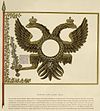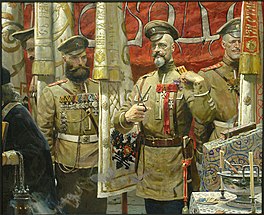Preobrazhensky Life Guards Regiment
| Preobrazhensky Lifeguard Regiment — III — Преображенский лейб-гвардии полк | |
|---|---|
 Preobrazhensky Regiment fighting the Battle of Paris, 30 March 1814, with Montmartre in the background | |
| Active | 1683–1917 2013–present as the 154th Preobrazhensky Independent Commandant's Regiment |
| Country | Tsardom of Russia Russian Empire Russian Federation |
| Branch | Army |
| Type | Infantry |
| Size | Regiment |
| Garrison/HQ | Saint Petersburg |
| Insignia | |
| Banner of the regiment |  |
| Badge of the regiment |  |
The Preobrazhensky
The Preobrazhensky Regiment was one of the oldest infantry regiments in Imperial Russia, along with the Semyonovsky Regiment. It served as a gendarmerie unit for the state Secret Chancellery, the first secret police of Russia headed by Prince Fyodor Romodanovsky. The regiment formed part of the 1st Brigade of the 1st Guards Infantry Division stationed on the Fontanka in Saint Petersburg. It was disbanded shortly before the October Revolution in 1917 by its last commander.
The Preobrazhensky Regiment was recreated in 2013 as the
History
The young Tsar
The regiment operated as the
In spite of its distinguished record, part of one battalion of the regiment mutinied in June 1906, at a time of
Colonel Alexander Kutepov (later a general) became the last commander of the regiment in April 1917; he disbanded the formation in December 1917 in the wake of the October Revolution of November 1917. In 2013 the regiment re-formed within the Russian Armed Forces as the 154th Preobrazhensky Independent Commandant's Regiment.
Timeline
This section needs additional citations for verification. (March 2013) |
- 1683 – droll regiments. Initially the number of soldiers was fewer than fifty.
- 1687 – Droll regiments become the Semenovsky regimentand Preobrazhensky regiments of the regular army.
- 1695 – Preobrazhensky regiment (nine companies) takes part in the Azov campaigns.
- 1696 – The regiment is divided into four battalions and two separate companies of bombardiers and grenadiers.
- 1700–1720 - Takes part in all major battles of the Great Northern War.
- 1700 – Before the Leib-GuardPreobrazhensky regiment.
- 1706 – Tsar Peter the Great adopts the military rank of colonel of Preobrazhensky regiment.
- 1722 – Takes part in the war against Persia.
- 1722 – According to Russian Table of Ranks soldiers of Preobrazhensky regiment were to be considered two ranks higher than in ordinary units.
- 1726 – Moscow company of Preobrazhensky regiment becomes a separate Moscow life-guard battalion and later Murom leib-guard battalion.
- 1737–1739 – War against Ottoman Empire.
- 1737 – Takes part in the Battle of Ochakov.
- 1742 – War against Sweden.
- 1762 – On 17 July declared first and highest in the military order of precedence in the Imperial Russian Guard.
- 1789–1790 - War against Sweden.
- 1796 – Battalions of the Preobrazhensky regiment are named according to their chiefs: 1st battalion - His Majesty, 2nd battalion - Lieutenant-General Tatischev, 3d Battalion - General Field-Marshal Arakcheev.
- 1805 – As a part of the Grand Duke's Corps of Guards the 1st and 3rd battalions leave St. Petersburg for Austria on 22 August; on 2 December take part in the battle of Austerlitz and return to St. Petersburg on 19 April 1806.
- 1807 – In February the Regiment, consisting of all 4 battalions, starts the march as a part of Grand Duke's Corps of Guards; on 5 June engages Ney's troops near Guttstadt and Altkirchen and on 14 June takes part in the battle of Friedland; returns to St. Petersburg in August.
- 1808 – On 9 September the 2nd battalion of the regiment enters the Corps of Major-General Vilmanstrand (Finland).
- 1809 – On 10 March, being a part of the Corps of Lieutenant-General Prince Bagration, starts its march to Sweden through the Åland islands; on 14 March fights the enemy's rearguard on the island of Lemland; on 17 March stops on the Eckerö island, closest to the Swedish shore, and after the talks with Sweden begins moving back; returns to St. Petersburg in October.

- 1811 – The regiment is transformed into 3 battalions; each battalion now comprises one grenadier company (grenadier and tirailleur platoons) and three fusilier companies.
- 1812 – As a part of the Grand Duke's Corps of Guards, the regiment moves in March to Borodino. During the French retreat from Moscow the regiment was in the reserve all the time and returns to Vilno in December.
- 1813 – On 13 January, the Guard crosses the Yermolov, is distinguished in the Battle of Kulm.
- 1814 – On 13 January in the presence of the Emperor Tuileries. After staying in Paris for more than two months the Regiment leaves for Normandy, embarking at Cherbourg on 15 June and on 12 August entering St. Petersburg through the Triumphal arch, constructed by the Emperor's order in the memory of excellent service of the Guard in 1812–1814.
- 1877–1878 - War against Ottoman Empire.
- 1906 – First Battalion excluded from the regiment and stripped of Life-Guard privileges, instead the new first battalion of the regiment is formed from cavaliers of the Order of St. George and heroes of the Russo-Japanese War.[2]
- 1914–1917 - Participated in World War I.
- 1917 – Garrison battalions participated in the Tsar Nicholas II. Disbanded in December by Alexander Kutepov, its last commander.
- 2013 – Re-established as the 154th Preobrazhensky Independent Commandant's Regiment.
Basis of recruitment
In the 18th and 19th centuries, officers of the Preobrazhensky Regiment were young Russian aristocrats and appointment was considered a proof of loyalty to the government and the
After 1874 ordinary soldiers of the Preobrazhensky Regiment were mainly conscripts undertaking their obligation to serve for three years in the active army and fifteen years in the reserve (Opolchaniya).[4] For the Preobrazhensky Regiment conscripts were selected for their height and fair hair (in order to provide a standardised appearance on parade).[5][6]
Flag
The regimental flag was of St. George's colours, with the inscription: "For displayed feats in battle of Kulm 17th of August 1813". (29 August 1813 in the Julian calendar).[7]
This colour was given to the regiment in order to celebrate its action at Kulm, where the outnumbered Preobrazhensky regiment withstood the charge of French troops.[7]
Uniforms


Throughout its history the regiment wore the standard uniform of the Infantry of the Imperial Guard, which from 1683 to 1914 was predominantly of a dark green (eventually verging on black) colour. The main distinctions of the Preobrazhensky Regiment were the red
Following the Russo-Turkish War, the regiment was awarded a small bronze scroll to be worn as a battle-honour on shakos and other headdresses. In 1883, in recognition of its overall distinguished record, officers of the regiment were authorised to wear a large metal gorget inscribed "1683-1850-1883". A second model of gorget, designed in imitation of that worn during the 18th century was approved for the regiment in 1910.[9]
During World War I the Preobrazhensky Regiment retained the distinction of white edgings on the khaki-grey field uniforms adopted in 1909 (see illustration of commanding officer and senior ncos opposite).
Rank insignia
Officers
| Description | Officer ranks | ||||||||
|---|---|---|---|---|---|---|---|---|---|
| Years | 1857—1904 | 1880—1884 | 1857—1904 | ||||||
| Epaulettes | |||||||||

|

|

|

|

|

|

|
|||
| Years | 1857—1917 | 1904—1917
| |||||||
| Epaulettes | 
|

|

|

|

|

|
|||

|

|

|

|

|

|

|
|||
| Description | Rank insignia | ||||||||
Shoulderboards
| |||||||||

|

|

|

|

|

|

|

|

| |
| Rank | Major general | Colonel | Lieutenant colonel | Major | Captain
|
Staff captain | Lieutenant | Junior lieutenant | Warrant officer |
| Type | Generals
|
Senior officers | Junior officers | ||||||
Enlisted and NCOs
| Description | Rank insignia for 1907—1917 | ||||||
|---|---|---|---|---|---|---|---|
Shoulderboards
| |||||||
 
|
 
|

|

|

|

|

| |
| Description | Rank insignia for 1894—1917 | ||||||
Shoulderboards
| |||||||
 
|
 
|

|

|

|

|

| |
| Ranks | Warrant officer first class | Warrant officer second class | Feldwebel | Senior unteroffizier |
Junior unteroffizier |
Corporal | Private |
| Type | NCOs | Enlisted | |||||
Sailors of the Preobrazhensky
An unusual feature of the Preobrazhensky Regiment was that it included a small detachment of sailors. Intended to commemorate a period during the reign of Peter the Great when the regiment served on board ship as temporary marines, this unit provided rowers for members of the Imperial Family when embarked on ceremonial barges on the Neva. The Preobrazhensky sailors wore naval dress, distinguished by orange stripes on the neck-collar.[10]
Preobrazhensky March

The "Preobrazhensky Regiment March" (
Before World War I it was used as the presentation march in several military formations in Prussia[11] Since 1964 it has been used as the slow march of the Royal Marines.[13][11]
Several lyrics are known for the march.[14]
Notable people who served in the Preobrazhensky Regiment
- Abram Petrovich Gannibal (1696–1781)
- Gavrila Derzhavin (1743–1816)
- Modest Mussorgsky (1839–1881)
- Alexander Kutepov (1882–1930)
See also
References
- ^
Bobrovskii, P (1899). Poteshnye i nachalo Probrazhenskago polka [The toy soldiers and the origin of the Preobrazhensky Regiment] (PDF) (in Russian). Saint Petersburg. p. 6. Retrieved 6 March 2021.
{{cite book}}: CS1 maint: location missing publisher (link) - ^ a b Patrick de Gmeline, pages 334-336 "La Garde Imperiale Russe 1896-1914", publisher Charles-Lavauzelle Paris 1986
- ^ BBC Radio 3. Composer of the Week, broadcast 26 October 2009
- ^ David Woodward, page 74 "Armies of the World 1854-1914", publisher G. P. Putman's Sons New York, SBN: 399-12252-4
- ^ Patrick de Gmeline, page 26 "La Garde Imperiale Russe 1896-1914", publisher Charles-Lavauzelle Paris 1986
- ISBN 978-0-297-85266-7.
- ^ a b Patrick de Gmeline, page 25 "La Garde Imperiale Imperiale Russe 1896-1914", publisher Charles-Lavauzelle Paris 1986
- ISBN 978-0-7524-8634-5.
- ^ Patrick de Gmeline, pages 26 "La Garde Imperiale Russe 1896-1914", publisher Charles-Lavauzelle Paris 1986
- ^ Patrick de Gmeline, pages 26-27 "La Garde Imperiale Russe 1896-1914", publisher Charles-Lavauzelle Paris 1986
- ^ a b c "История марша Лейб-Гвардии Преображенского полка", reprinted from the article Агафонов Н., Петров Ф. "Марш лейб-гвардии Преображенского полка", Оркестр, 2007
- ^ "National Anthem | Russia's State Symbols". En.rian.ru. RIA Novosti. Archived from the original on 4 February 2009. Retrieved 30 November 2013.
- ^ "The Regimental Marches of Her Majesty's Royal Marines:A Life on the Ocean Wave Regimental Quick March". Royalmarinesbands.co.uk. Archived from the original on 3 December 2013. Retrieved 30 November 2013.
- ^ "Russian Anthems museum". Hymn.ru. 14 April 2013. Archived from the original on 3 July 2013. Retrieved 30 November 2013.
External links
- History of Preobrazhensky regiment - in Russian
- Preobrazhensky March - Regimental anthem
